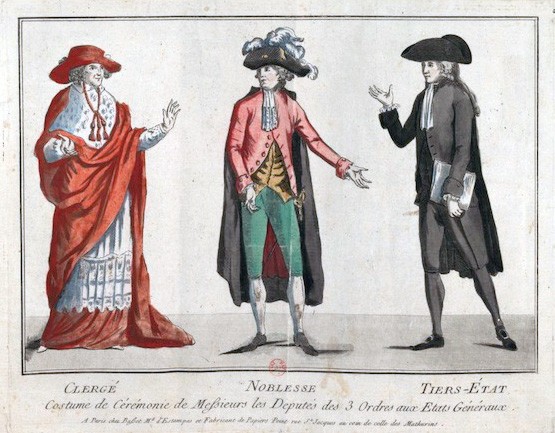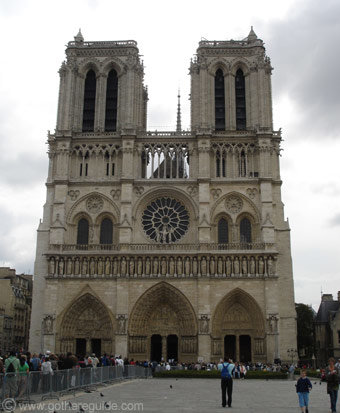
Before the revolution, French society was divided into three estates or orders. The First Estate contained around 130,000 ordained members of the Catholic church: from archbishops and bishops down to parish priests, monks, friars and nuns. With religion still a powerful force in 18th-century France, the clergy exerted considerable influence over matters of state and in French society. Despite inequalities and endemic corruption in its own ranks, the Third Estate also enjoyed substantial privileges and exemptions.
An ideological stronghold
The First Estate occupied a prestigious place in the social order. Belief in God, religion and the afterlife dominated late 18th century Europe, so for ordinary people the church and its clergy were the only avenues for understanding or accessing God and the afterlife. The church, therefore, had an ideological stronghold over the people and was an integral part of France’s social and political framework.
Religion also underpinned royal authority by reinforcing the king’s divine right to the throne. Members of the higher clergy, such as cardinals and archbishops, served as political advisors to the king. The state gave the Catholic church a virtual monopoly over religious matters; there were no other approved religions in France.
The church was also responsible for social policy and welfare, as well as carrying out some functions of the state. Its clergy conducted and registered marriages, baptisms and funerals; they delivered education to children and distributed charity to the poor. In rural areas, the local parish priest (or curé) was both a central figure and an influential leader in his community.
A repository of wealth
The church’s importance allowed it to accumulate vast amounts of wealth. The church owned roughly 10 percent of all land in France and collected revenue of around 150 million livres each year, mainly from tenant rents and tithes. Tithes were annual donations of goods or money, in effect a ‘church tax’ paid by its parishioners.
The church’s vast annual income was complemented by an exemption from state taxes. This exemption, however, was not without its challenges. Ministers in the royal government during the 17th and 18th centuries often demanded the church contribute a greater share toward the running of the state.
These demands could produce heightened tensions and fierce negotiations, particularly in times of war when the government was raising funds for its military needs. As a compromise, church leaders agreed to provide the state with a don gratuit (‘voluntary gift’), a payment made every five years. By the early 1700s, the First Estate was paying a don gratuit of between three and four million livres – a sizeable amount but still only around two percent of the church’s total revenue. The don gratuit was, in effect, a bribe, paid by the church to retain its tax-exempt status.
The higher clergy
The church’s considerable wealth tended to accumulate at the top, rather than filtering down to its lower tiers. Most of the church’s higher clergy – cardinals, archbishops and bishops – acquired significant levels of personal wealth from land rents, sinecures or simple graft or skimming off the top.
A great number of higher clergymen lived lives of opulence and extravagance, not dissimilar to affluent nobles in the Second Estate. Around two-thirds of bishops and archbishops had noble titles, either given as gifts from the crown or purchased venally. Church dioceses spent vast amounts of money building and maintaining huge cathedrals, such as Val-de-Grace and Notre Dame in Paris. These buildings overshadowed cities and towns, symbolising the church’s dominance over French society.
The clergy was not only exempt from paying personal taxation, they could not be called up for military service. Churchmen accused of serious crimes could only be tried in ecclesiastical courts – in other words, by fellow members of the clergy – rather than in civil courts.
“So long as the [French] population retained its keen awareness of the choice between eternal salvation and damnation in the next life, the prestige of the First Estate was assured, for the church alone provided the means to salvation… Its members occupied an important place at every level of society, from the humble country parish to the royal court itself; and politically the status of the First Estate reflected the power of religion in France and justified the royal title of His Most Christian Majesty.”
JH Shennan
Criticism of the church
In particular, there was growing discontent with the higher clergy, dominated by a rising sense that many bishops and archbishops acted in their own personal interests rather than the interests of God or the church.
Evidence reveals a growing disenchantment and lack of trust in the church. By the late 1700s, fewer people were joining the priesthood or religious orders, while fewer people were leaving their estates to the church after death. A growing number of people drifted away from the Catholic church, either to Freemasonry, Protestant religions or religious apathy and indifference. Many who remained in the church believed it was in need of reform and purging of corruption.

Ordinary clergy
This rising dissatisfaction was not only confined to laymen. There was also growing unrest among the lower ranks of the clergy.
While all ordained persons belonged to the First Estate there was, nevertheless, a diversity of political and theological viewpoints in their ranks. Around one-third of all clergy were parish priests or curés. Most of these priests well educated, hardworking, compassionate and respected by the people in their parish. But parish priests were often disregarded by the higher clergy and poorly paid by the church.
During the 1700s a gulf began to emerge between some priests, who lived among the poor of the Third Estate and were witness to their sufferings, and the princes of the church. Many priests welcomed the summoning of the Estates General in mid-1789, where they were well represented (208 of the First Estate delegates at the Estates General were parish priests). In many cahiers de doleance the lower clergy called for greater democracy and consultation in church decision making, as well as a review of the church’s exemption from taxation.
The dissatisfaction and growing liberalism of the lower clergy would later by seen in their actions at the Estates General, when 149 of their deputies opted to join the Third Estate to form the National Assembly.

1. The First Estate was one of France’s three social orders. It contained all persons ordained in a Catholic religious order, from cardinals and archbishops down to priests, monks and nuns.
2. The First Estate wielded considerable ideological power and political influence in France, due to the strong religious beliefs of the majority of the population.
3. The church was also incredibly wealthy. It was a significant owner of land, collected rents and tithes, yet also avoided paying any significant amount of tax to the state.
4. On the eve of the French Revolution the church was subject to disillusionment and criticism, with many of its parishioners concerned about the corruption and failings of the clergy.
5. These criticisms could be found within the ranks of the church itself, with many members of the lower clergy demanding a greater say and more accountability.
Citation information
Title: ‘The First Estate’
Authors: Jennifer Llewellyn, Steve Thompson
Publisher: Alpha History
URL: https://alphahistory.com/frenchrevolution/first-estate/
Date published: September 14, 2019
Date updated: November 5, 2023
Date accessed: April 26, 2024
Copyright: The content on this page is © Alpha History. It may not be republished without our express permission. For more information on usage, please refer to our Terms of Use.
